Reflective Essay: Gibbs Reflection on Nursing Clinical Experience
VerifiedAdded on 2023/06/04
|6
|1422
|127
Essay
AI Summary
This reflective essay details a nursing student's experience in a mental health unit, focusing on an incident involving a patient with personality disorder and schizophrenia. The student utilizes the Gibbs reflection cycle to analyze the event, encompassing description, feelings, evaluation, analysis, and action plan. The essay highlights the student's initial nervousness, the challenges in patient interaction, and the importance of nonverbal communication. The analysis identifies a lack of expertise in effective communication as a weakness, leading to a plan for professional development through supervisor guidance, online courses, and workshops. The conclusion emphasizes the significance of establishing a strong therapeutic relationship and the student's commitment to improving skills for safe and effective practice, ultimately aiming to enhance patient care. The assignment demonstrates the application of the Gibbs model to promote professional growth, and the student's ability to reflect on their practice and plan for future development.
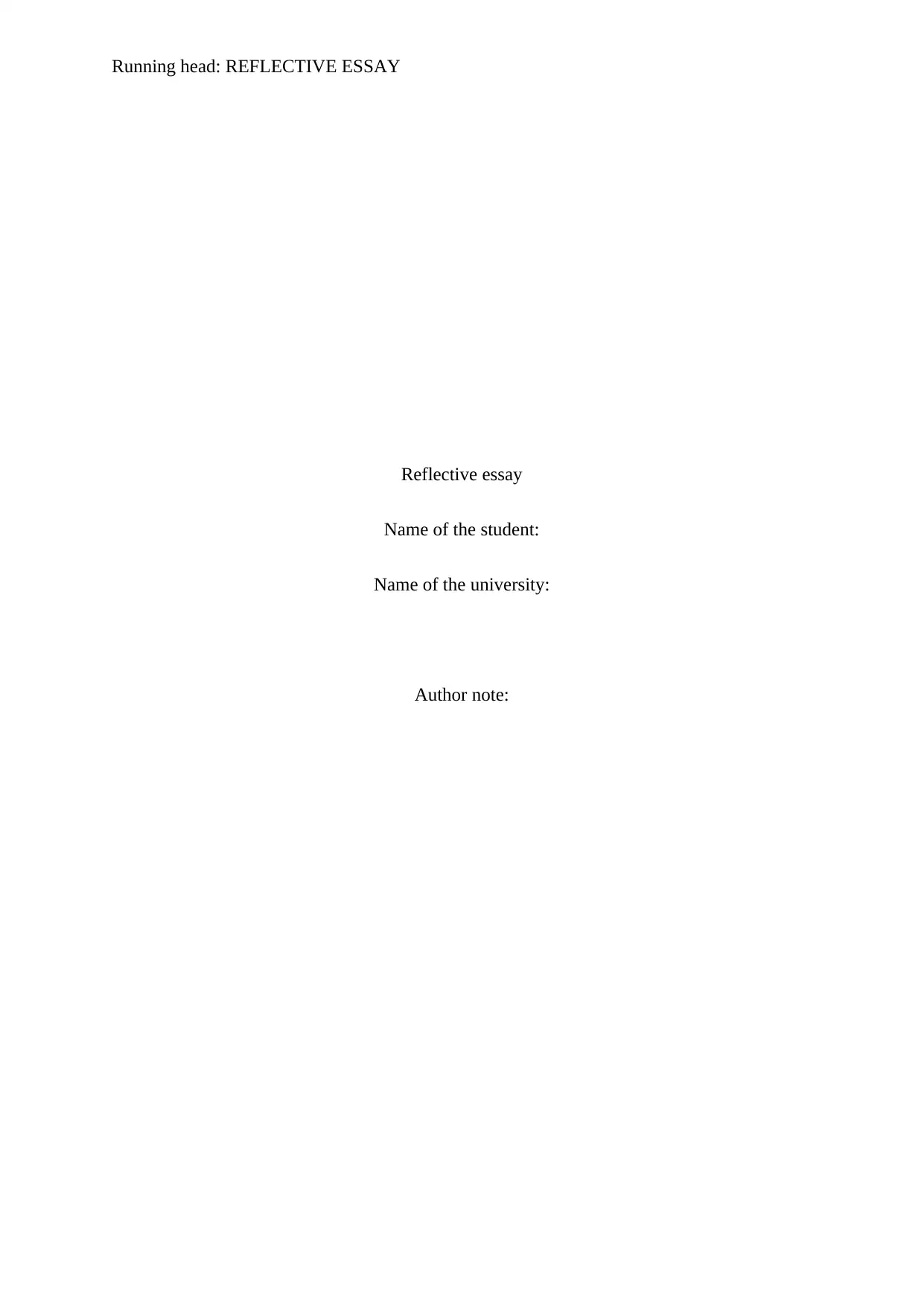
Running head: REFLECTIVE ESSAY
Reflective essay
Name of the student:
Name of the university:
Author note:
Reflective essay
Name of the student:
Name of the university:
Author note:
Paraphrase This Document
Need a fresh take? Get an instant paraphrase of this document with our AI Paraphraser
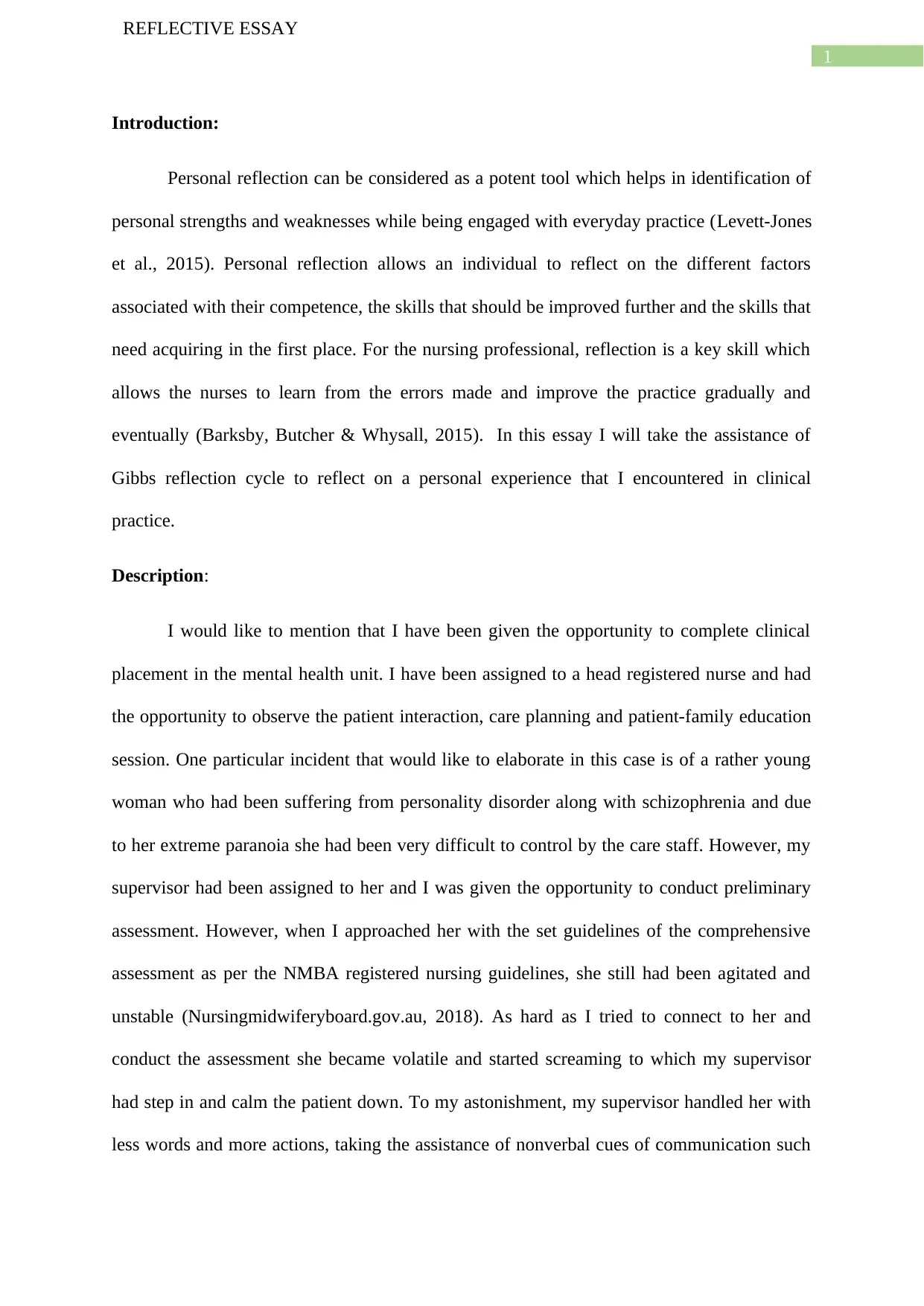
1
REFLECTIVE ESSAY
Introduction:
Personal reflection can be considered as a potent tool which helps in identification of
personal strengths and weaknesses while being engaged with everyday practice (Levett-Jones
et al., 2015). Personal reflection allows an individual to reflect on the different factors
associated with their competence, the skills that should be improved further and the skills that
need acquiring in the first place. For the nursing professional, reflection is a key skill which
allows the nurses to learn from the errors made and improve the practice gradually and
eventually (Barksby, Butcher & Whysall, 2015). In this essay I will take the assistance of
Gibbs reflection cycle to reflect on a personal experience that I encountered in clinical
practice.
Description:
I would like to mention that I have been given the opportunity to complete clinical
placement in the mental health unit. I have been assigned to a head registered nurse and had
the opportunity to observe the patient interaction, care planning and patient-family education
session. One particular incident that would like to elaborate in this case is of a rather young
woman who had been suffering from personality disorder along with schizophrenia and due
to her extreme paranoia she had been very difficult to control by the care staff. However, my
supervisor had been assigned to her and I was given the opportunity to conduct preliminary
assessment. However, when I approached her with the set guidelines of the comprehensive
assessment as per the NMBA registered nursing guidelines, she still had been agitated and
unstable (Nursingmidwiferyboard.gov.au, 2018). As hard as I tried to connect to her and
conduct the assessment she became volatile and started screaming to which my supervisor
had step in and calm the patient down. To my astonishment, my supervisor handled her with
less words and more actions, taking the assistance of nonverbal cues of communication such
REFLECTIVE ESSAY
Introduction:
Personal reflection can be considered as a potent tool which helps in identification of
personal strengths and weaknesses while being engaged with everyday practice (Levett-Jones
et al., 2015). Personal reflection allows an individual to reflect on the different factors
associated with their competence, the skills that should be improved further and the skills that
need acquiring in the first place. For the nursing professional, reflection is a key skill which
allows the nurses to learn from the errors made and improve the practice gradually and
eventually (Barksby, Butcher & Whysall, 2015). In this essay I will take the assistance of
Gibbs reflection cycle to reflect on a personal experience that I encountered in clinical
practice.
Description:
I would like to mention that I have been given the opportunity to complete clinical
placement in the mental health unit. I have been assigned to a head registered nurse and had
the opportunity to observe the patient interaction, care planning and patient-family education
session. One particular incident that would like to elaborate in this case is of a rather young
woman who had been suffering from personality disorder along with schizophrenia and due
to her extreme paranoia she had been very difficult to control by the care staff. However, my
supervisor had been assigned to her and I was given the opportunity to conduct preliminary
assessment. However, when I approached her with the set guidelines of the comprehensive
assessment as per the NMBA registered nursing guidelines, she still had been agitated and
unstable (Nursingmidwiferyboard.gov.au, 2018). As hard as I tried to connect to her and
conduct the assessment she became volatile and started screaming to which my supervisor
had step in and calm the patient down. To my astonishment, my supervisor handled her with
less words and more actions, taking the assistance of nonverbal cues of communication such
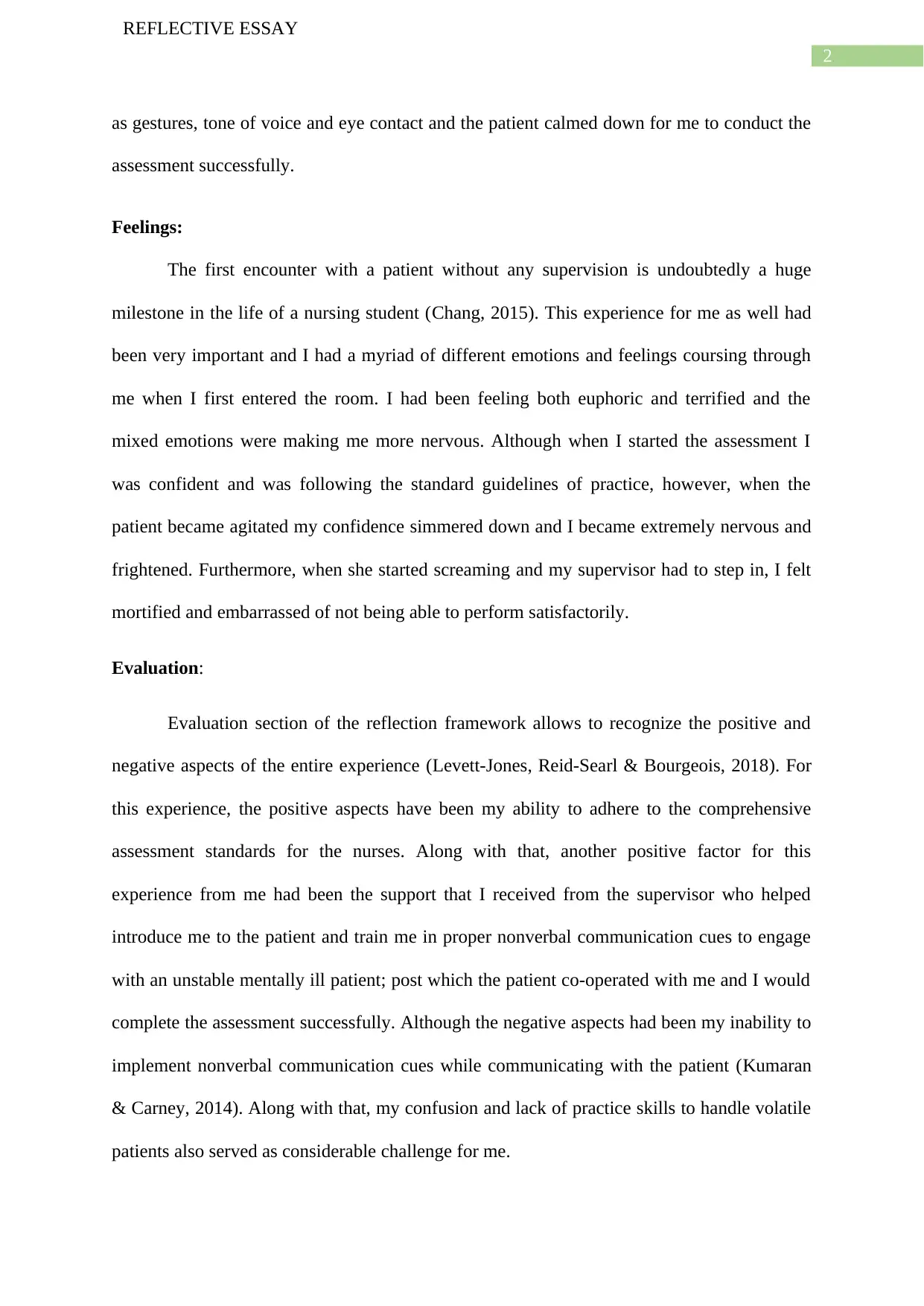
2
REFLECTIVE ESSAY
as gestures, tone of voice and eye contact and the patient calmed down for me to conduct the
assessment successfully.
Feelings:
The first encounter with a patient without any supervision is undoubtedly a huge
milestone in the life of a nursing student (Chang, 2015). This experience for me as well had
been very important and I had a myriad of different emotions and feelings coursing through
me when I first entered the room. I had been feeling both euphoric and terrified and the
mixed emotions were making me more nervous. Although when I started the assessment I
was confident and was following the standard guidelines of practice, however, when the
patient became agitated my confidence simmered down and I became extremely nervous and
frightened. Furthermore, when she started screaming and my supervisor had to step in, I felt
mortified and embarrassed of not being able to perform satisfactorily.
Evaluation:
Evaluation section of the reflection framework allows to recognize the positive and
negative aspects of the entire experience (Levett-Jones, Reid-Searl & Bourgeois, 2018). For
this experience, the positive aspects have been my ability to adhere to the comprehensive
assessment standards for the nurses. Along with that, another positive factor for this
experience from me had been the support that I received from the supervisor who helped
introduce me to the patient and train me in proper nonverbal communication cues to engage
with an unstable mentally ill patient; post which the patient co-operated with me and I would
complete the assessment successfully. Although the negative aspects had been my inability to
implement nonverbal communication cues while communicating with the patient (Kumaran
& Carney, 2014). Along with that, my confusion and lack of practice skills to handle volatile
patients also served as considerable challenge for me.
REFLECTIVE ESSAY
as gestures, tone of voice and eye contact and the patient calmed down for me to conduct the
assessment successfully.
Feelings:
The first encounter with a patient without any supervision is undoubtedly a huge
milestone in the life of a nursing student (Chang, 2015). This experience for me as well had
been very important and I had a myriad of different emotions and feelings coursing through
me when I first entered the room. I had been feeling both euphoric and terrified and the
mixed emotions were making me more nervous. Although when I started the assessment I
was confident and was following the standard guidelines of practice, however, when the
patient became agitated my confidence simmered down and I became extremely nervous and
frightened. Furthermore, when she started screaming and my supervisor had to step in, I felt
mortified and embarrassed of not being able to perform satisfactorily.
Evaluation:
Evaluation section of the reflection framework allows to recognize the positive and
negative aspects of the entire experience (Levett-Jones, Reid-Searl & Bourgeois, 2018). For
this experience, the positive aspects have been my ability to adhere to the comprehensive
assessment standards for the nurses. Along with that, another positive factor for this
experience from me had been the support that I received from the supervisor who helped
introduce me to the patient and train me in proper nonverbal communication cues to engage
with an unstable mentally ill patient; post which the patient co-operated with me and I would
complete the assessment successfully. Although the negative aspects had been my inability to
implement nonverbal communication cues while communicating with the patient (Kumaran
& Carney, 2014). Along with that, my confusion and lack of practice skills to handle volatile
patients also served as considerable challenge for me.
⊘ This is a preview!⊘
Do you want full access?
Subscribe today to unlock all pages.

Trusted by 1+ million students worldwide
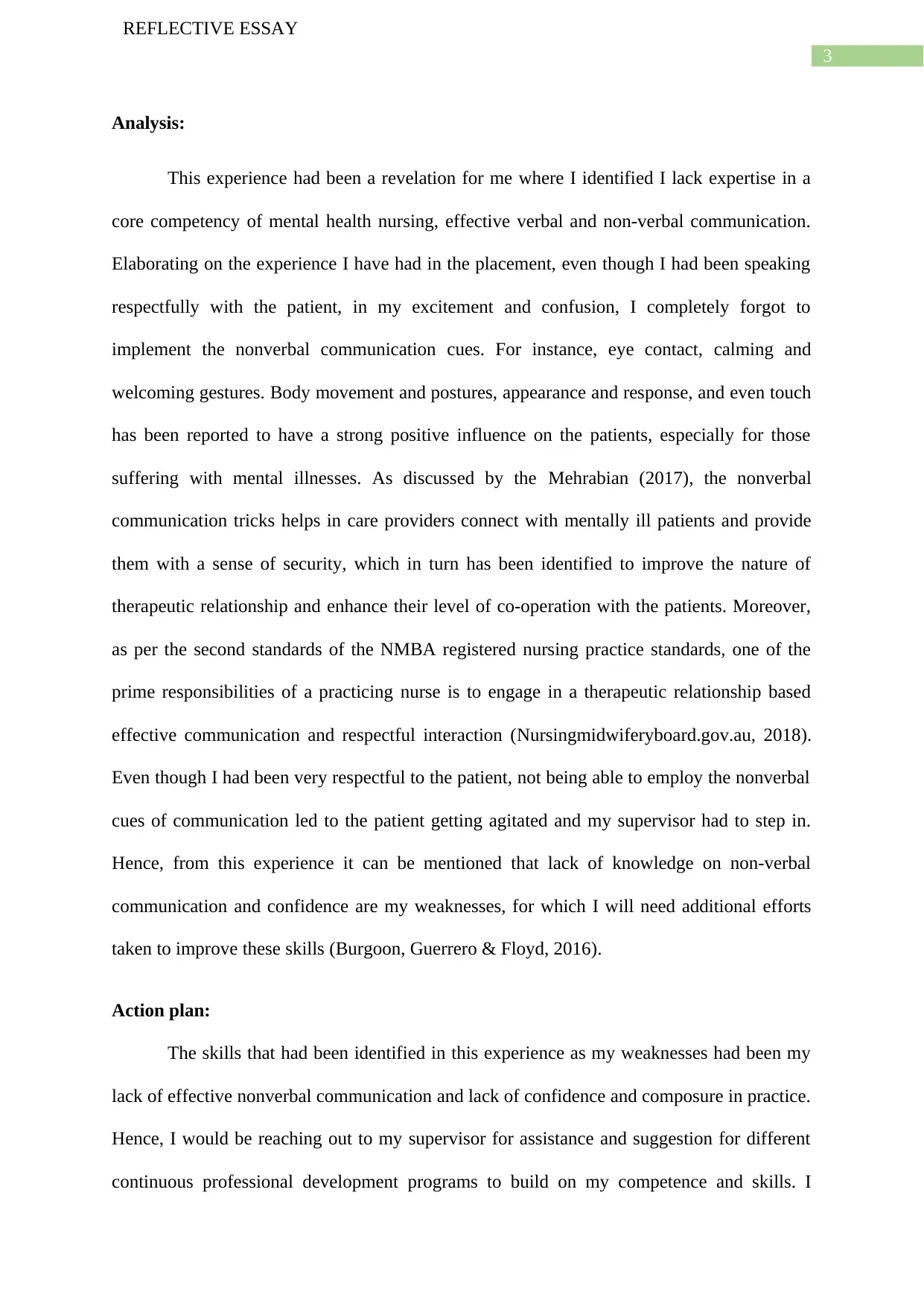
3
REFLECTIVE ESSAY
Analysis:
This experience had been a revelation for me where I identified I lack expertise in a
core competency of mental health nursing, effective verbal and non-verbal communication.
Elaborating on the experience I have had in the placement, even though I had been speaking
respectfully with the patient, in my excitement and confusion, I completely forgot to
implement the nonverbal communication cues. For instance, eye contact, calming and
welcoming gestures. Body movement and postures, appearance and response, and even touch
has been reported to have a strong positive influence on the patients, especially for those
suffering with mental illnesses. As discussed by the Mehrabian (2017), the nonverbal
communication tricks helps in care providers connect with mentally ill patients and provide
them with a sense of security, which in turn has been identified to improve the nature of
therapeutic relationship and enhance their level of co-operation with the patients. Moreover,
as per the second standards of the NMBA registered nursing practice standards, one of the
prime responsibilities of a practicing nurse is to engage in a therapeutic relationship based
effective communication and respectful interaction (Nursingmidwiferyboard.gov.au, 2018).
Even though I had been very respectful to the patient, not being able to employ the nonverbal
cues of communication led to the patient getting agitated and my supervisor had to step in.
Hence, from this experience it can be mentioned that lack of knowledge on non-verbal
communication and confidence are my weaknesses, for which I will need additional efforts
taken to improve these skills (Burgoon, Guerrero & Floyd, 2016).
Action plan:
The skills that had been identified in this experience as my weaknesses had been my
lack of effective nonverbal communication and lack of confidence and composure in practice.
Hence, I would be reaching out to my supervisor for assistance and suggestion for different
continuous professional development programs to build on my competence and skills. I
REFLECTIVE ESSAY
Analysis:
This experience had been a revelation for me where I identified I lack expertise in a
core competency of mental health nursing, effective verbal and non-verbal communication.
Elaborating on the experience I have had in the placement, even though I had been speaking
respectfully with the patient, in my excitement and confusion, I completely forgot to
implement the nonverbal communication cues. For instance, eye contact, calming and
welcoming gestures. Body movement and postures, appearance and response, and even touch
has been reported to have a strong positive influence on the patients, especially for those
suffering with mental illnesses. As discussed by the Mehrabian (2017), the nonverbal
communication tricks helps in care providers connect with mentally ill patients and provide
them with a sense of security, which in turn has been identified to improve the nature of
therapeutic relationship and enhance their level of co-operation with the patients. Moreover,
as per the second standards of the NMBA registered nursing practice standards, one of the
prime responsibilities of a practicing nurse is to engage in a therapeutic relationship based
effective communication and respectful interaction (Nursingmidwiferyboard.gov.au, 2018).
Even though I had been very respectful to the patient, not being able to employ the nonverbal
cues of communication led to the patient getting agitated and my supervisor had to step in.
Hence, from this experience it can be mentioned that lack of knowledge on non-verbal
communication and confidence are my weaknesses, for which I will need additional efforts
taken to improve these skills (Burgoon, Guerrero & Floyd, 2016).
Action plan:
The skills that had been identified in this experience as my weaknesses had been my
lack of effective nonverbal communication and lack of confidence and composure in practice.
Hence, I would be reaching out to my supervisor for assistance and suggestion for different
continuous professional development programs to build on my competence and skills. I
Paraphrase This Document
Need a fresh take? Get an instant paraphrase of this document with our AI Paraphraser
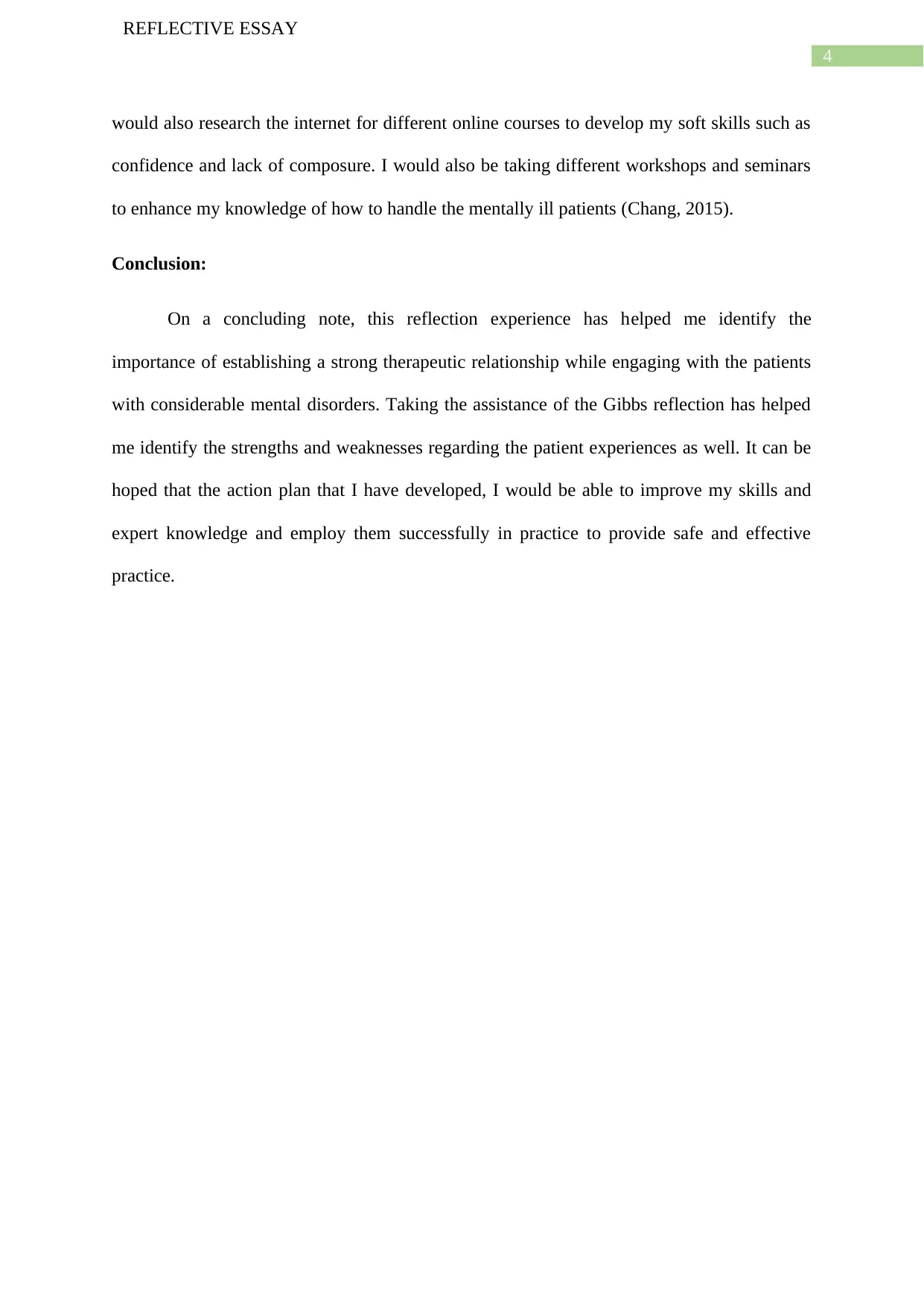
4
REFLECTIVE ESSAY
would also research the internet for different online courses to develop my soft skills such as
confidence and lack of composure. I would also be taking different workshops and seminars
to enhance my knowledge of how to handle the mentally ill patients (Chang, 2015).
Conclusion:
On a concluding note, this reflection experience has helped me identify the
importance of establishing a strong therapeutic relationship while engaging with the patients
with considerable mental disorders. Taking the assistance of the Gibbs reflection has helped
me identify the strengths and weaknesses regarding the patient experiences as well. It can be
hoped that the action plan that I have developed, I would be able to improve my skills and
expert knowledge and employ them successfully in practice to provide safe and effective
practice.
REFLECTIVE ESSAY
would also research the internet for different online courses to develop my soft skills such as
confidence and lack of composure. I would also be taking different workshops and seminars
to enhance my knowledge of how to handle the mentally ill patients (Chang, 2015).
Conclusion:
On a concluding note, this reflection experience has helped me identify the
importance of establishing a strong therapeutic relationship while engaging with the patients
with considerable mental disorders. Taking the assistance of the Gibbs reflection has helped
me identify the strengths and weaknesses regarding the patient experiences as well. It can be
hoped that the action plan that I have developed, I would be able to improve my skills and
expert knowledge and employ them successfully in practice to provide safe and effective
practice.
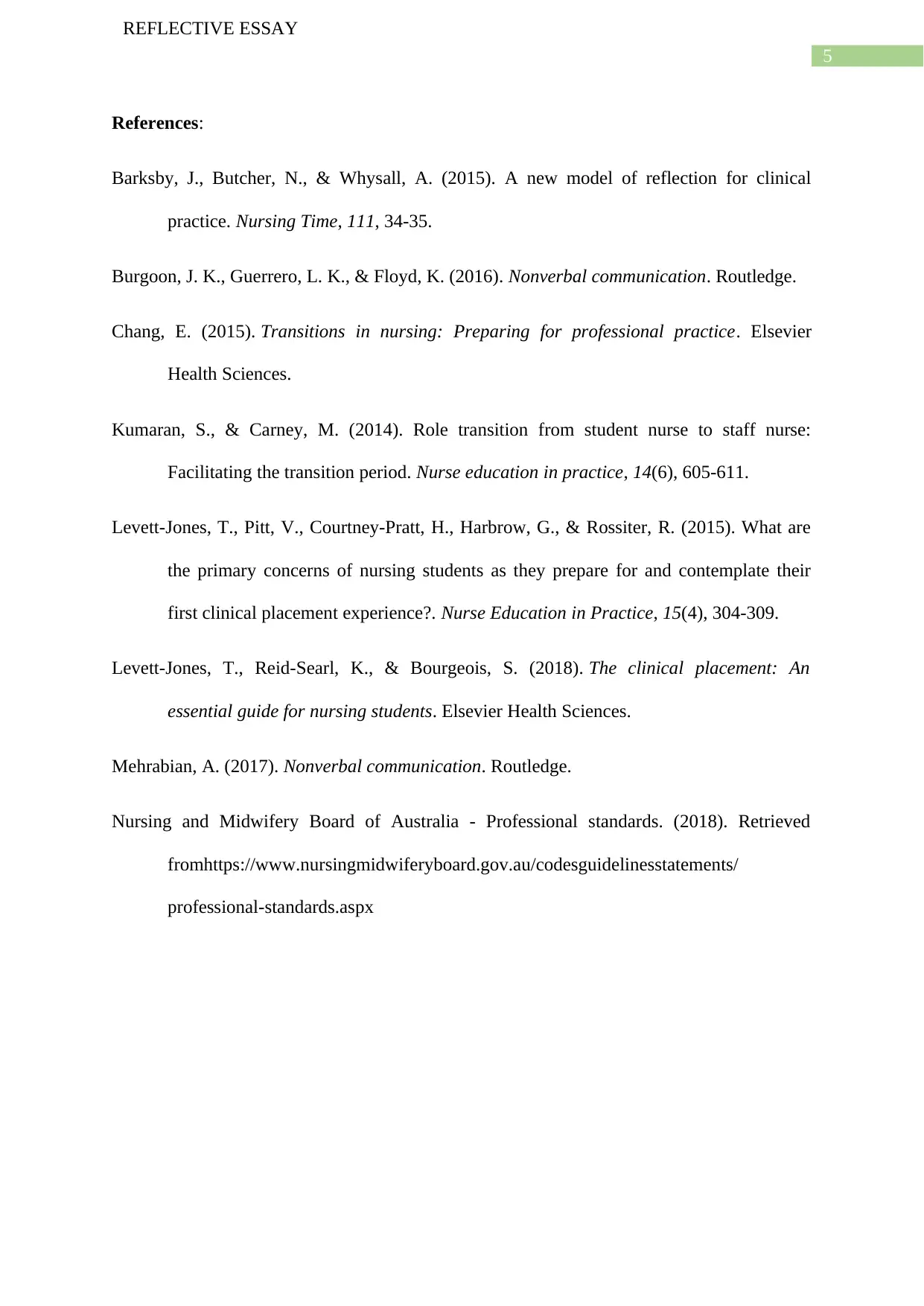
5
REFLECTIVE ESSAY
References:
Barksby, J., Butcher, N., & Whysall, A. (2015). A new model of reflection for clinical
practice. Nursing Time, 111, 34-35.
Burgoon, J. K., Guerrero, L. K., & Floyd, K. (2016). Nonverbal communication. Routledge.
Chang, E. (2015). Transitions in nursing: Preparing for professional practice. Elsevier
Health Sciences.
Kumaran, S., & Carney, M. (2014). Role transition from student nurse to staff nurse:
Facilitating the transition period. Nurse education in practice, 14(6), 605-611.
Levett-Jones, T., Pitt, V., Courtney-Pratt, H., Harbrow, G., & Rossiter, R. (2015). What are
the primary concerns of nursing students as they prepare for and contemplate their
first clinical placement experience?. Nurse Education in Practice, 15(4), 304-309.
Levett-Jones, T., Reid-Searl, K., & Bourgeois, S. (2018). The clinical placement: An
essential guide for nursing students. Elsevier Health Sciences.
Mehrabian, A. (2017). Nonverbal communication. Routledge.
Nursing and Midwifery Board of Australia - Professional standards. (2018). Retrieved
fromhttps://www.nursingmidwiferyboard.gov.au/codesguidelinesstatements/
professional-standards.aspx
REFLECTIVE ESSAY
References:
Barksby, J., Butcher, N., & Whysall, A. (2015). A new model of reflection for clinical
practice. Nursing Time, 111, 34-35.
Burgoon, J. K., Guerrero, L. K., & Floyd, K. (2016). Nonverbal communication. Routledge.
Chang, E. (2015). Transitions in nursing: Preparing for professional practice. Elsevier
Health Sciences.
Kumaran, S., & Carney, M. (2014). Role transition from student nurse to staff nurse:
Facilitating the transition period. Nurse education in practice, 14(6), 605-611.
Levett-Jones, T., Pitt, V., Courtney-Pratt, H., Harbrow, G., & Rossiter, R. (2015). What are
the primary concerns of nursing students as they prepare for and contemplate their
first clinical placement experience?. Nurse Education in Practice, 15(4), 304-309.
Levett-Jones, T., Reid-Searl, K., & Bourgeois, S. (2018). The clinical placement: An
essential guide for nursing students. Elsevier Health Sciences.
Mehrabian, A. (2017). Nonverbal communication. Routledge.
Nursing and Midwifery Board of Australia - Professional standards. (2018). Retrieved
fromhttps://www.nursingmidwiferyboard.gov.au/codesguidelinesstatements/
professional-standards.aspx
⊘ This is a preview!⊘
Do you want full access?
Subscribe today to unlock all pages.

Trusted by 1+ million students worldwide
1 out of 6
Related Documents
Your All-in-One AI-Powered Toolkit for Academic Success.
+13062052269
info@desklib.com
Available 24*7 on WhatsApp / Email
![[object Object]](/_next/static/media/star-bottom.7253800d.svg)
Unlock your academic potential
Copyright © 2020–2025 A2Z Services. All Rights Reserved. Developed and managed by ZUCOL.



